Archive for the ‘Helicopter Damselfly’ Tag

The transition from the wet into the dry season is normally marked by a variety of changes that are both easy to see and hear. So far those changes have not been that obvious for 2017. The unusually heavy rains during November and December last year would appear to have delayed, if not completely altered a lot of plant and animal behaviors. But now, some two months after expecting to see certain changes, they are beginning to take place.
There has been a late start to the flowering season for many trees. This week some of the trees that would have been expected to flower in December are now flowering in February. One notable example is the Ajo Tree, (Caryocar costarincensis). Its bright lemon yellow blooms can now be seen littering the forest floor on many of the trails. Take a trip up into the tree tops on the canopy platform and you will find many species of tree crowns covered in flowers. This is turn attracts many butterflies and they can be seen flying from flower to flower, tree to tree, all around the sunlit forest canopy.

Ajo Tree, (Caryocar costaricensis). Flowers.
Rain forests in general can be windless areas. The forests of the Osa Peninsula experience very little wind except when a heavy rain approaches pushing a pocket of air in front of it. The plants therefore have to rely for the most part on animals to carry out both pollination and seed dispersal. Bats are very important pollinators and seed dispersers. Bats prefer musky odors to sweet odors. This results in the plants emitting various scents that humans would not be expecting, being used to the more fragrant sweet smell of flowers. The bats however are attracted by the scent of garlic. The nectar feeding bats have a long muzzle and a long sticky tongue. While they are feeding on the nectar, the long anthers of the flower dust pollen over the head and shoulders of the bat which then flies off to visit another flower transferring the pollen and effecting pollination.
In subtle contrast to the green of the hedgerow vegetation are the strong purples of the Morning Glory, (Ipomea) which are currently flowering. This is a vine which wends its way through the hedges. The purple color is attractive to insects. The flowers prefer the full sun despite the name “Morning Glory” which refers to the flowers unfurling at first light of dawn.

Morning Glory, (Ipomoea sp)
The butterflies are starting to be seen in greater numbers but the levels fall a long way short of what would be expected at this time of year. The height of the butterfly season is between February and March but so far the visible populations, particularly of some species, are noticeably down.
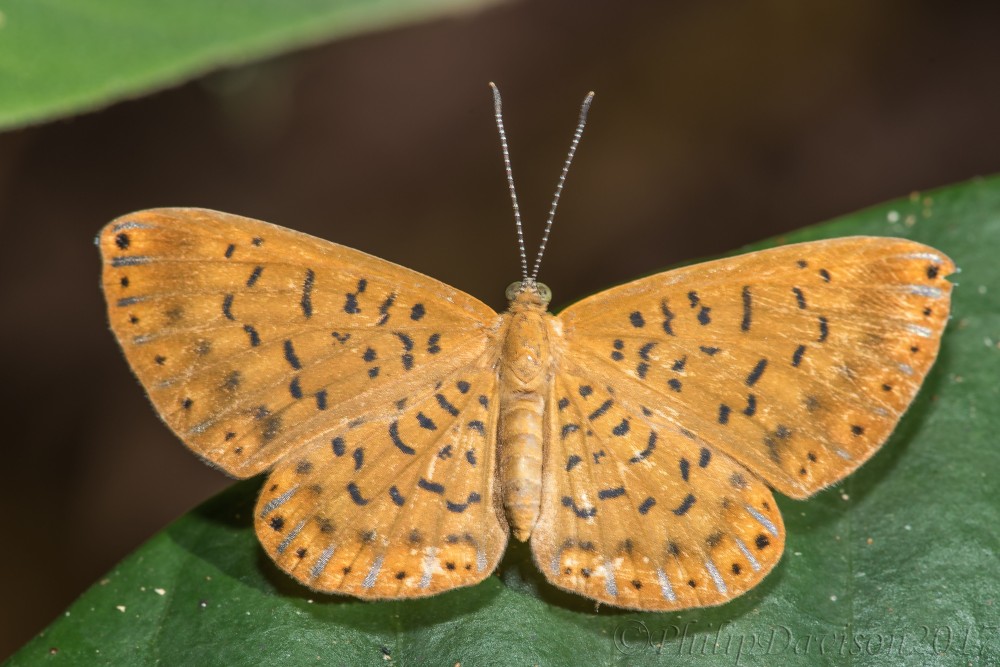
Metacharis victrix
At night the number of amphibians is starting to diminish. For some time now the number of species has reduced to 4 or 5 but the number of individuals of each species has dwindled to only one or two hopeful males calling for a mate. It is highly unlikely that there will be a response at this time of year. The Savage’s Thin-fingered Frogs, (Leptodactylus savagei), are increasing slightly in numbers around the pond. As the area continues to dry the pond is the only damp refuge and these large amphibians start to congregate around the pond edge sometimes entering the water where they can be found floating.
Floral Descent
Whereas many of the plants have been slow to flower, some of the orchids have not.. To see the orchids you generally need to up in the forest canopy, 88% of the Costa Rican orchids are epiphytic, they are up at the top of the trees. But occasionally you may be lucky to see some that have found a suitable location nearer to the ground. When not in bloom it is easy to miss them as many orchids have small insignificant flowers, but not all, others when in flower can have quite a showy display. Orchidaceae is a very species rich family of flowering plants rivalled only by the Asteraceae or daisy family in terms of numbers. Being so diverse makes them hard to identify. Many people admire them for their aesthetic, if sometimes subtle, beauty. They are therefore a group of greater interest to orchid specialists in terms of identification and geographical distribution. Equaled by the diversity of species and form of the flowers are the number of ways in which orchids become pollinated. Some of them have evolved means of attracting pollinators that would seem to be, on first reading, the stuff purely of science fiction.
Around the gardens and forests there are orchids that are slightly more obvious. Growing on some of the garden trees as epiphytes are the white-flowered, night-perfumed Lady of the Night, (Brassavola nodosa). At night the white flowers give off a heavy sweet perfume that attracts in hawkmoths. The moths hover in front of the flower and using the long proboscis probe for nectar. While doing so they become covered in pollen which is then transferred to the next flower they visit. Not too far away growing in the borders are the Bamboo Orchids, (Arundina graminifolia). This is a terrestrial orchid native to south east Asia. It is however widely grown in Costa Rican gardens. The purple bee pollinated blooms are born on long thin stems that resemble a bamboo stem.
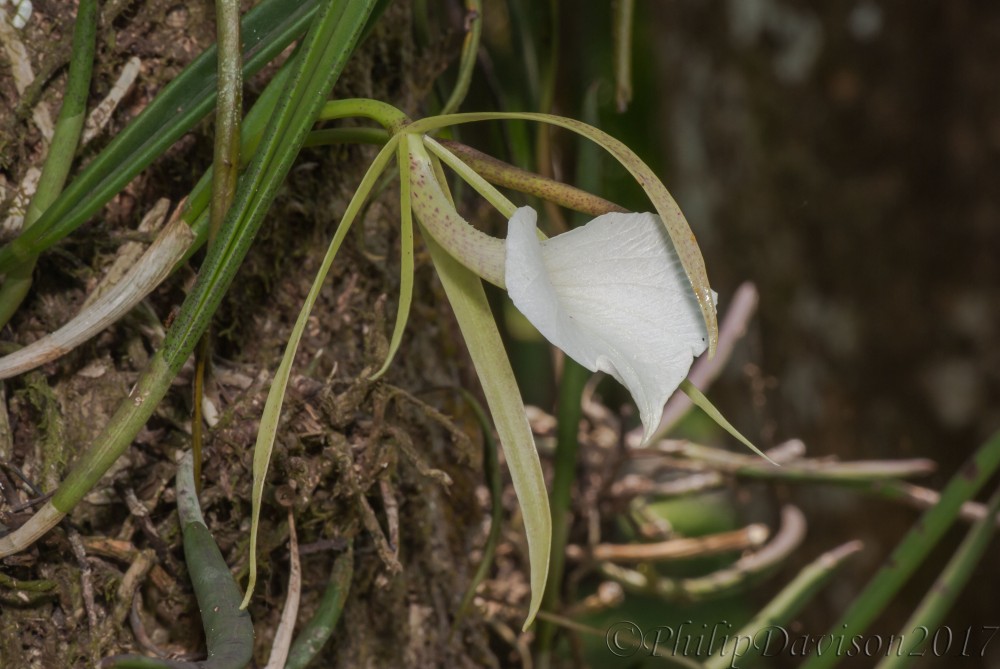
Lady of the Night, (Brassavola nodosa)
On the forest trails growing low down and in locations near to water you may find, (Stanhopea cirrhata). Stanhopea species emit an scent that attracts certain species of orchid bee. The males gather the scent which they mix with other plant volatiles to produce their own perfumes. The structure of the Stanhopea orchid is such that while the bee is gathering the scent a pollen package is attached to the bee which unwittingly transfers it to the next orchid it visits.
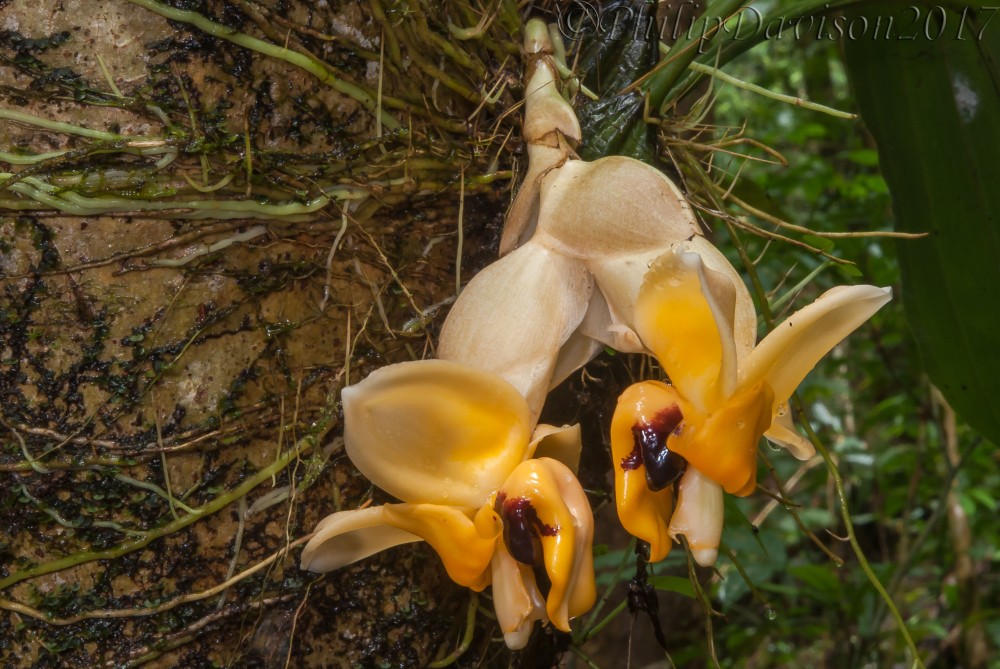
Stanhopea cirrhata
There are some orchids whose flowers are as green as their leaves. Numbering amongst them is the Vanilla Orchid, (Vanilla planifolia). In the wild Vanilla orchids are pollinated by orchid bees but when commercially grown and pollinated by hand. Growing on the sides of trees are some of the green flowered Epidendrum Orchids. There are about 160 species of Epidendrum in Costa Rica which makes them a little difficult to identify.
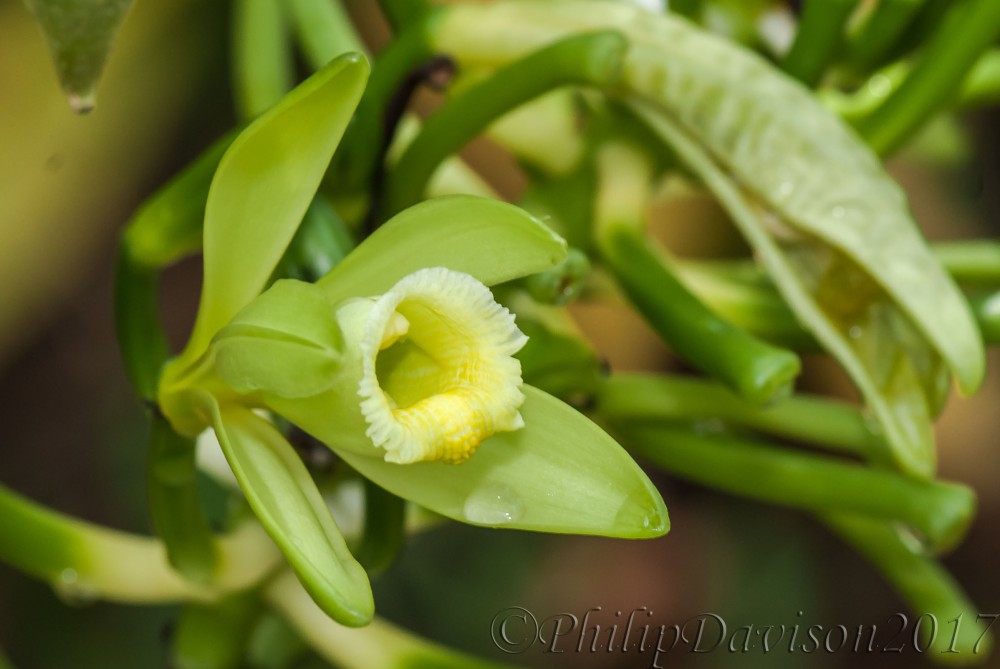
Vanilla Orchid, (Vanilla planifolia)
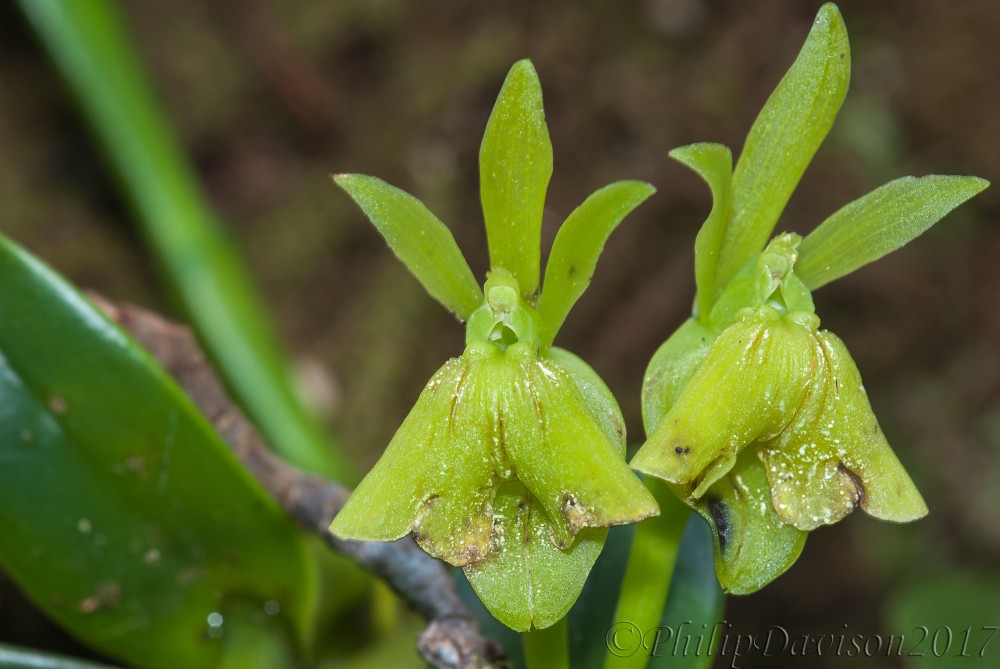
Epidendrum sp
Dragons and Damsels
If you spend enough time by any body of water around the grounds then you are likely to see some of the Odonates; dragonflies and damselflies. The dragonflies can more commonly be found still bodies of water such as the pond whereas the damselflies seem to frequent areas closer to running water such as the creek. They can also be seen in the gardens and throughout the forest too. You can tell a dragon from a damsel when they land as the dragonflies perch with the wings out to the sides whereas the damselflies perch with the wings folded together over the back.
You have to have patience to photograph dragon and damselflies. They react to the slightest movement near them by taking to the air. They do have favored perches though so if you set the camera up on a tripod or simply rest in a comfortable position, camera in hand, they well almost always return in short time and alight at the place from which they took off.
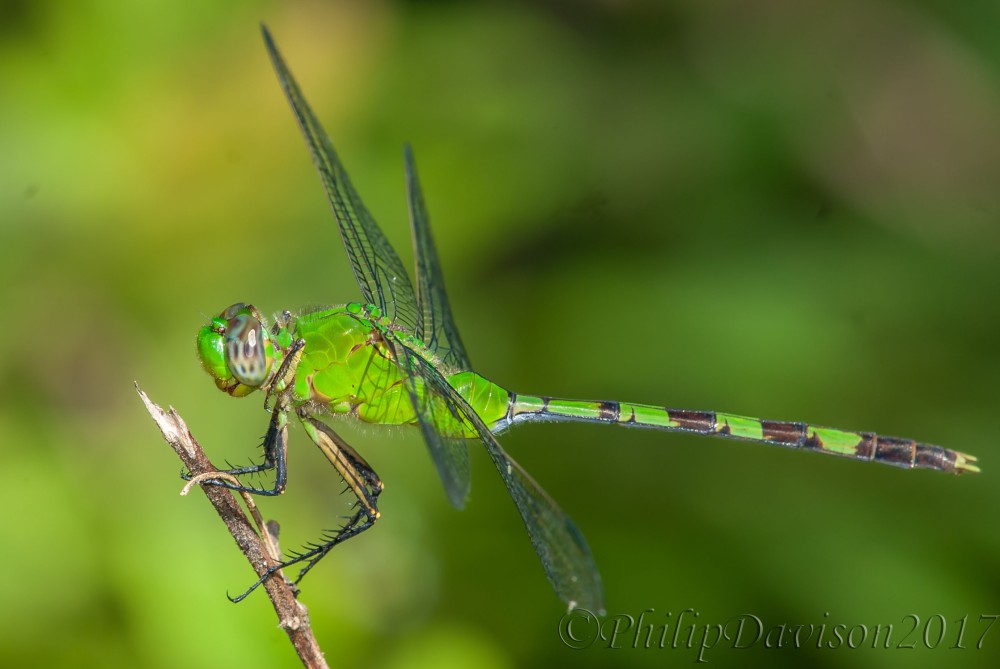
Great Pondhawk, (Erythemis vesiculosa)

Red-mantled Dragonlet, (Erythrodiplax fervida)
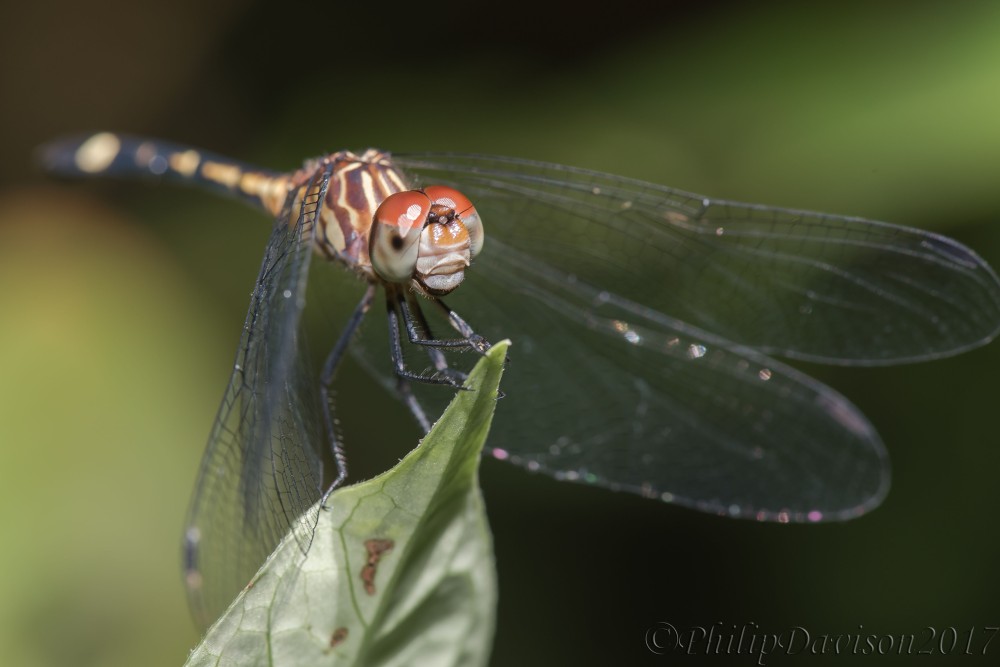
Three-striped Dasher, (Micrathyria didyma)
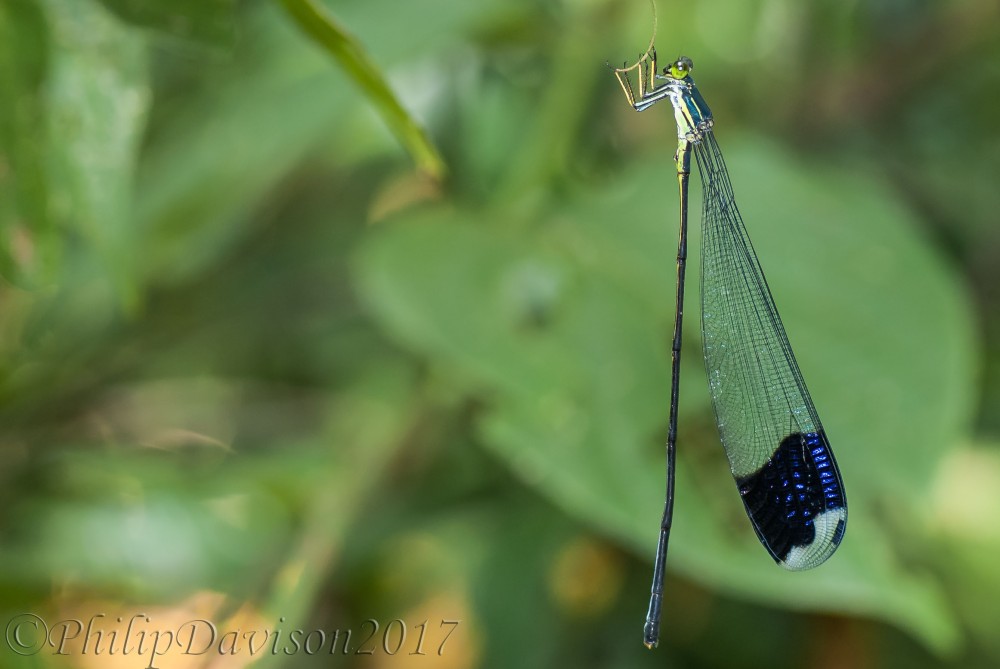
Helicopter Damselfly, (Megaloprepus caerulatus)
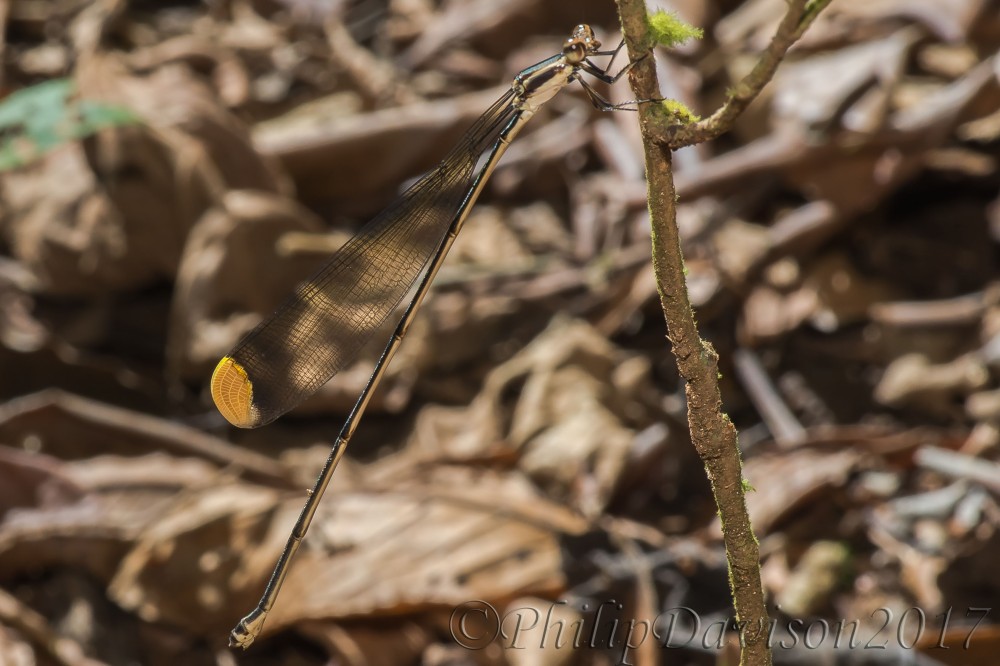
Ornate Helicopter Damselfly, (Mecisogaster ornata)
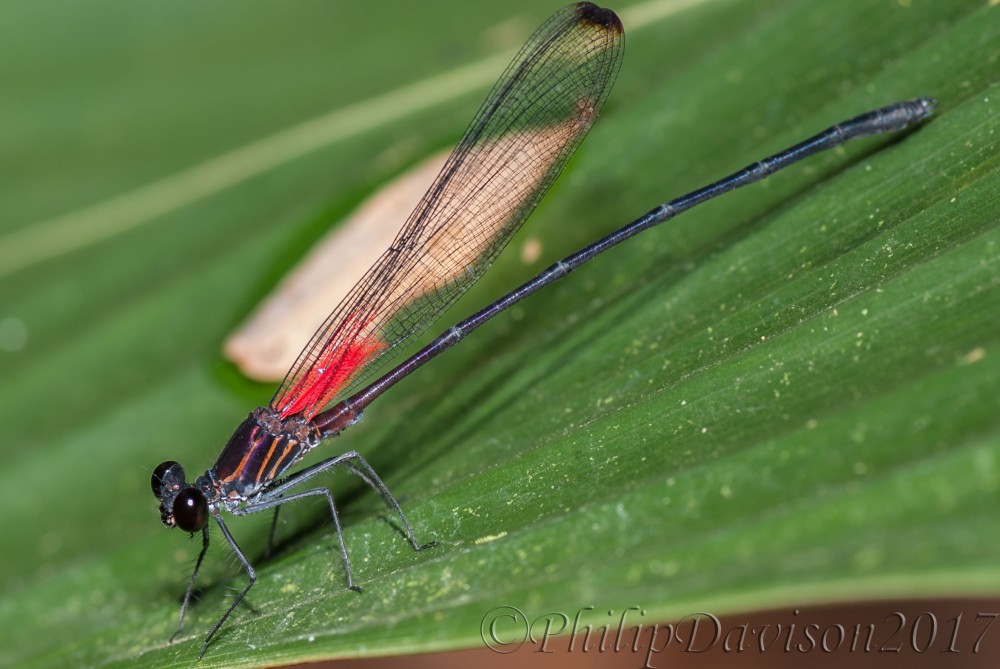
Hetaerina orissa
Philip Davison is a Biologist, Writer and Photographer Based in Costa Rica

Monday 18th January 2016
Hair Trigger

Spiders are an amazingly diverse group of animals, the eighth most diverse group of animals of the planet in actual fact. It doesn’t take long while poking around in the undergrowth to come across a spider. Some build webs and some don’t but they can all spin silk, the orb weavers having the ability to spin upto seven different types of silk. The non-orb weavers tend to be ambush predators, remaining motionless in a strategic location where potential prey may wander innocently by unaware of the imminent life threatening danger. The ambush position could be on the side of a wall, atop a leaf or sitting on a flower head.
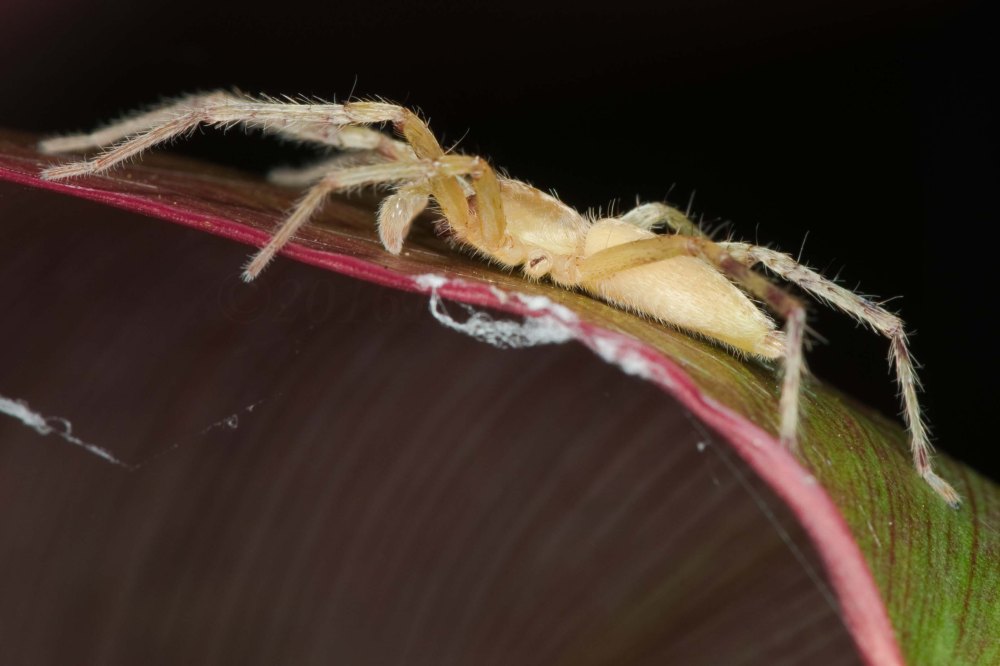
This Wandering Spider, (Cupiennius sp), was sitting perfectly still on a blank white wall at night. As many spiders are nocturnal predators the eyes play a lesser part in the identification and capture of a meal but that does not imply the spider is without the means by which to locate the exact location of its prey. The body, which at first sight looks smooth, upon closer examination can be seen to be covered in hairs of different lengths. These hairs form part of a battery of sensitive sense organs responsive to touch, vibration and moving eddies of air currents that allow the spider to detect a passing meal in the darkness.

The majority of hairs covering the body, which give most people the heebie-jeebies with regards to spiders, are tactile and touch sensitive, the stimulus of which will cause the spider to attack or run away. Between the shorter hairs, particularly on the legs are long fine hairs called trichobothria. These are super sensitive to the slightest movement in air currents which can be a giveaway for any larger creature passing by which could make a nice meal. The Wandering Spiders can even detect insects such as moths flying overhead which they jump and grab straight out of the air.
For those more stealthy prey items whose movements are too slow to disturb the air, they cannot avoid causing small vibrations of the substrate and the spiders are attuned to this also. Around the body but more particularly around the leg joints are slit sense organs which allow the spider to detect any vibrations moving through the substrate upon which it is placed.
Whereas the Wandering Spiders rely on their tactile senses at night during the day there are spiders that actively hunt down their prey visually. The Jumping Spiders prefer to hunt in full sun. The most obvious feature are the large anterior eyes with which they can locate and subsequently stalk their victims. They stealthily approach to the point where the potential meal is within striking distance. The spider braces itself and then pounce. The fangs are embedded upon impact, pumping venom into the victim which is held in a death grip by the front pair of legs.
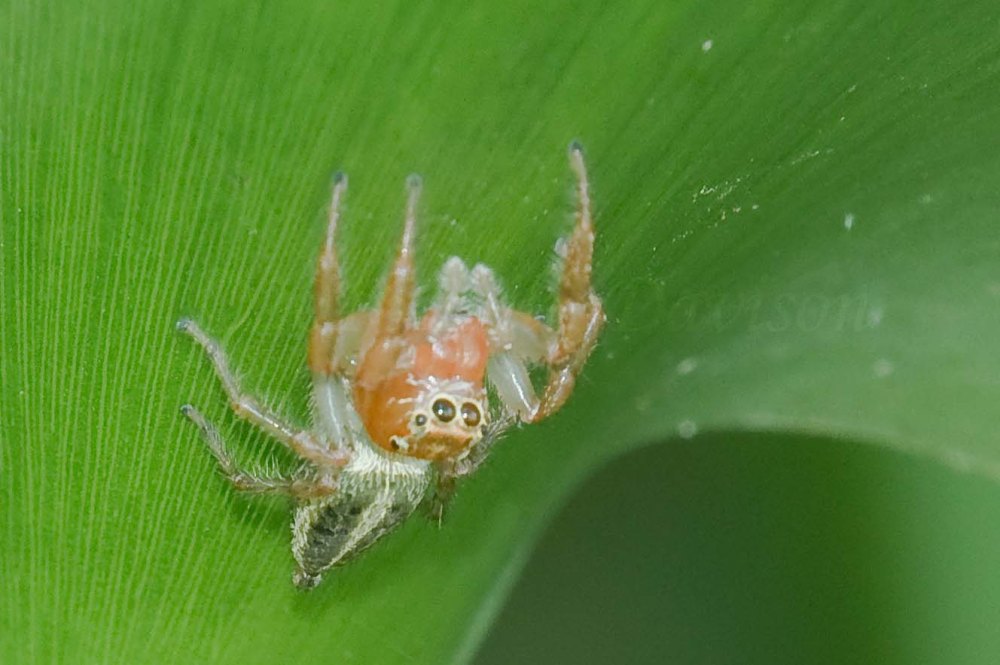
Hunting the Hunters
The spiders may be highly adapted carnivores with specialized hunting techniques but they too in turn have predators specialized to catch and eat them. Not the least of these are the giant Helicopter Damselflies, (Megaloprepus caerulatus), the largest damselflies on the planet. They can be seen flying along the sunlit trails through the forest. The peculiar motion of the blue/black tipped wings gives the impression of rotating helicopter blades. What may at first seem like a somewhat erratic flight pattern actually has design. The more astute observer will notice that they have the ability to fly vertically up and down as well as horizontally in and out. But what are they seeking? The large eyes and acute vision are scanning spider webs in front of which they momentarily hover scanning for the silken structures builder. Once located the spider is grabbed in the legs of the damselfly which goes into reverse gear before biting off the spiders head and legs to finally gorge itself on the soft body parts.
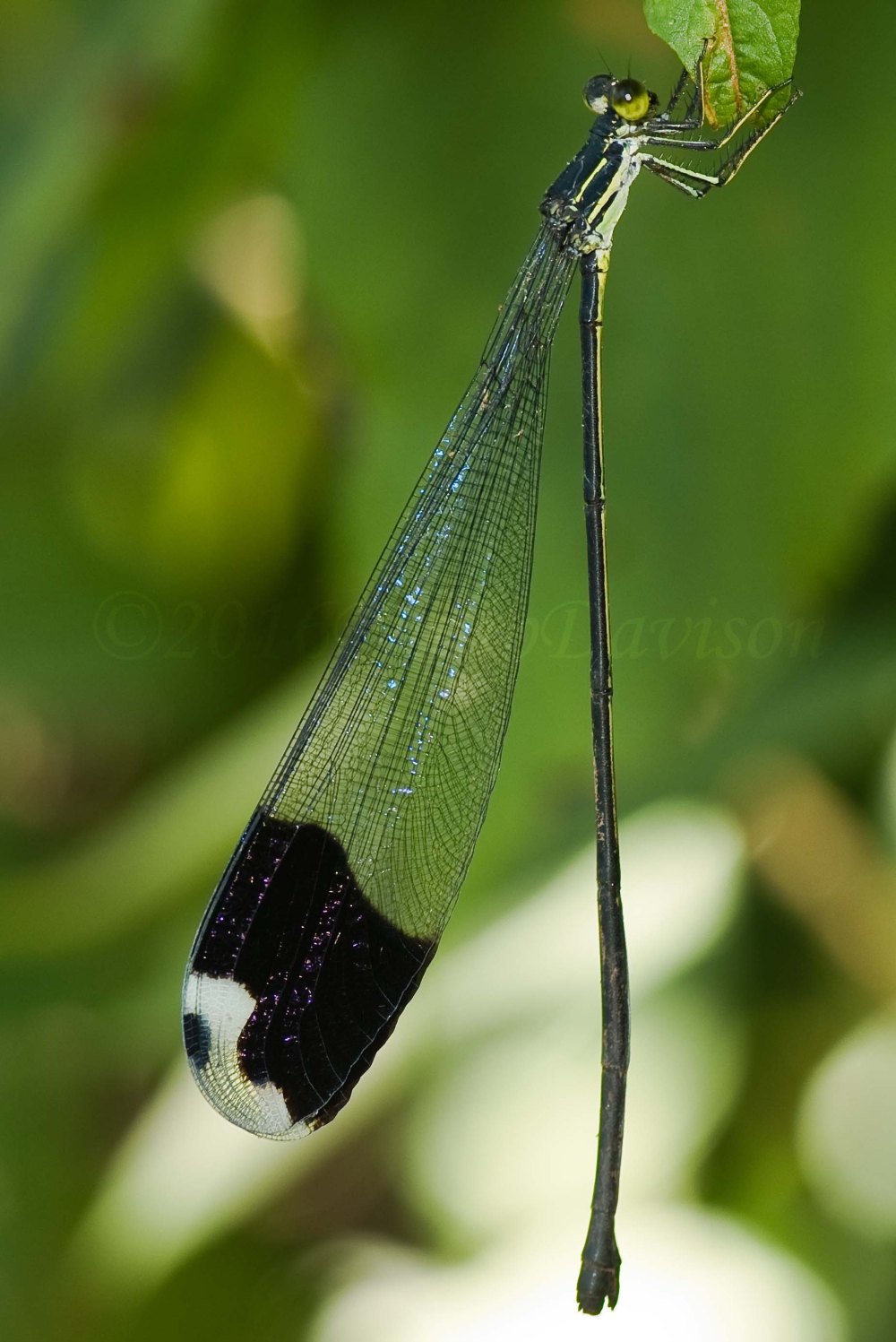
The damselflies can be recognized when they alight by the habit of folding the wings together over the body. Their cousins, the dragonflies keep the wings held out to the sides when at rest. During the day it is not too often that they do rest. Each individual has a perch from which it frequently takes off to investigate any passing creature that might make a meal or another dragonfly that might prove to be a mate or another dragonfly that might be a rival for that meal or mate. They make aerial sorties swooping at speed, hovering in place and if unmoved to action return to the perch for a short while before they are off again on another sortie.

They differ from the more delicate damselflies not only by how they hold their wings but also in the structural placement of the eyes. Damselflies have two large compound eyes widely separated on either side of the head. Dragonflies have two large compound eyes that meet together for a greater or lesser part of their margins on top of the head. However no matter where the eyes are placed they allow for excellent diurnal vision which combined with the unsurpassed aerobatic proficiency make these some of the masterful airborne hunters.
As we move into the dry season the hot and parched conditions stimulate many of the plants into flowering. This is most certainly true of the orchids. There are two orchids that can be seen blooming at the moment in the area. One is a non native terrestrial orchid, the Bamboo Orchid and the other is a native epiphytic orchid.

The Bamboo Orchid is a native of South East Asia but is planted in many parts of Costa Rica as a beautiful ornamental edging plant. Bamboo refers to the long erect stalk that resembles that a of a bamboo grass. The attractive purple flowers appear throughout the year giving a nonstop display of color for the back of a flower border.

The majority of orchid species in Costa Rica are epiphytic, that is they grow on the outside of trees without harming them. Generally to see orchids you need to be at the top of the canopy, 88% of Costa Rica’s 1400 orchid species are to be found there. Many of the orchids flower from December into January but some may be seen flowering at any time of the year. This particular specimen was found growing close to the ground near the base of a large tree. Due to the diversity of genera and species the identification of orchids, like so many tropical plant and animal taxa, is the realm of specialists. For most visitors it is enough to see and enjoy the exotic blooms should you be lucky to encounter them.
Philip Davison is a biologist, writer and photographer based in Costa Rica.
Felipe del Bosque Blog November 18th 2013

Trying Times
This week started as the last week ended with lots of rain. Previously the rain had been falling at night but over the first few day of this week it started pouring day and night. Then a profound change occurred the sun came out and continued to return every morning to give us three days of beautiful dry conditions.
The transitional period between wet and dry season certainly make predictions difficult. Many aspects of plant and animal behavior rely on abiotic or environmental cues. Once we move into the dry season those changes will stimulate many of the plants to flower. Consequently there will be a lot of hummingbird, bat and insect activity around the nectar producing blooms. But as yet we are waiting for that change to occur.
Present and Correct
It has been quite a quiet week as far as mammal sightings are concerned. All the four species of monkey were spotted at many points around the grounds. Agoutis, (Dasyprocta punctata), can be seen on a daily basis near the Bosque restaurant. One was seen with a baby this week. Red-tailed Squirrels, (Sciurus granatensis), can be seen around the open areas of the lodge while Alfaro’s Pygmy Squirrel, (Microsciurus alfari), can be found without too much searching in the forest. These plain brown, sparse tailed, small chipmunk sized squirrels hop around at low levels of the forest and more often than not will cling head down on the side of a tree trunk and chatter ferociously at you.
Sing For Your Supper
The migrant birds, many of which are tanagers and warblers are still arriving. Summer Tanagers, (Piranga rubra), have set themselves territories in the gardens in front of the restaurant. Here they are joined by Cherrie’s Tanagers, (Ramphocelus costaricensus), males with their bright scarlet rumps being followed by harems of orange-brown females. Up in the branches of the trees are noisy flocks of Golden-hooded Tanagers, (Tangara larvata).
The army ant swarms continue their relentless marches through the forest at several locations on the property. They attract a lot of attendant bird life, many species of woodcreeper, trogons and of course the ever present Grey-headed Tanagers, (Eucometis penicillata).
Flying in the Face of Confusion
The migratory Green Urania, (Urania fulgens), moths are continuing to build in numbers. Butterfly numbers increase when the sun is shining but it will be several months before they hit their peak. Around the pond the dragonflies are starting to be seen more frequently, the bright blues and reds of these agile aerial hunters dart to and fro before settling momentarily of a leaf. Their heads turn this way and that, the acute vision with which they are gifted allows them to see predator, prey, mates and rivals, the presence of which causes the observer to react very quickly. Predators they avoid, prey they will catch, mates and rivals they will chase.
Within the darker confines of the forest flies an insect that both mesmerizes and inspires awe in those seeing it for the first time. Damselflies would be considered by most as being the smaller, more delicate relatives of the dragonflies. Here in the forests surrounding Bosque del Cabo flies the largest damselfly on the planet, the Helicopter Damselfly, (Megaloprepus caerulatus).

The first words used by guests upon returning from the forest where they have witnessed this spectacular creature for the first time are “I saw something flying like a helicopter”, or there were two large insects flying round each other.
The body is long and needle-shaped.with a broad tip. The wings are heavily veined and made of thin transparent tissue like clear cellophane. As the creature flies the wings catch the light and glint in the sun. But the confusing part about what is being seen is in no small part due to the bluey-black and silver-tips to the end of all four wings. When in flight they give the impression that the wings are moving in the same fashion as the rotor blades of a helicopter, hence the name.
The Helicopter Damselflies are spider-eating specialists. They have the ability to fly vertically up and down as well as horizontally in and out which you will see them do in front of a series of spider webs. When they find the silk spinner, they grab it in their legs, reverse backwards, nip of the head and legs then proceed to devour the softer body parts.
It is not uncommon to see the Helicopter Damselflies along the trails but it is not the easiest insect to photograph. When at rest they fold their wings back and over the body. This is your opportunity as it was mine. There is a smaller species, Mecisogaster ornata, which is also frequently seen and has yellow tips to the wings.
Little Flower
This week I decided to take a look at and photograph some of the plants that grow next to the roadside and are so often ignored. They are there every day and most flower continuously year round but everyone just walks by and doesn’t notice. But if you sink to your knees and go down to their level then you will see that they are just as pretty as the large showy blooms sported by many of the shrubs and trees..
One low growing herbaceous plant with deep green foliage offsetting its tiny yellow flowers is the Florecilla, (Baltimora recta). It belongs in the daisy family (Asteraceae). Another plant is the same family is the Dandelion, (Emilia fosbergii). It is not a plant native to the Americas, its origins belong in the Old World, but now its delicate pink and purple flowers can be seen decorating any sunny roadside throughout the country.



There are several sprawling ground huggers to be found everywhere on the Bosque verges. One has small yellow cup shaped flowers, Escobilla, (Sida rhombifolia). This plant is found all over the planet in tropical and subtropical open areas. Being so common you would think it would be familiar to a lot of people but probably only the discerning botanist would notice it. In many situations growing beside the Escobilla is a plant with small pink pom-poms as flowers. It is not the flowers that normally catch the attention with this plant but rather the leaves. When touched, the leaves instantly fold up and the stem droops. The reason for this is not entirely understood but there are several theories. It could be to escaped grazers but I can’t see why a folded leaf would not be consumed over an open leaf. When it rains the pounding of the droplets may damage the leaf so again it folds. Finally at night the leaves close. This may aid in reducing transpiration but once more in the evening when the temperature drops, the relative humidity of the air increases so I am not sure about that one either. Nonetheless it certainly remains a feature that in particular fascinates children.

Philip is a biologist, writer and photographer at Bosque del Cabo Rainforest lodge on the Osa Peninsula, Costa Rica.
www.bosquedelcabo.com
Text and Photographs are taken from the forthcoming book:
The Natural History of Bosque del Cabo by Philip Davison
Temperature and Rainfall
Average Daily Rainfall 0.37 ins. Total Weekly Rainfall 2.61 ins
Average Daily Rainfall 9.50 mm. Total Weekly Rainfall 66.3 mm
Highest Daily Temp 89°F. Lowest Daily Temp 74°F.
Highest Daily Temp 32.2°C. Lowest Daily Temp 23.7°C.
Species List for the Week
Mammals
- Central American Squirrel Monkey
- Mantled Howler Monkey
- Spider Monkey
- White-faced Capuchin Monkey
- Common Tent-making Bat
- Central American Woolly Opossum
- Agouti
- Red-tailed Squirrel
- White-nosed Coati
- Collared Peccary
Birds
- Red-lored Amazon
- Scarlet Macaw
- Great Curassow
- Black Hawk
- Black-hooded Antshrike
- Chestnut-back Antbird
- Common Paureque
- Lineated Woodpecker
- Pale-Billed Woodpecker
- Blue-crowned Motmot
- Short-billed Pigeon
- Long-billed Hermit
- Purple-crowned Fairy
- Stripe-throated Hermit
- Red-capped Manakin
- Streak-headed Woodcreeper
- Wedge-billed Woodcreeper
- Fiery-billed Aracari
- Chestnut-mandibled Toucan
- Summer Tanager
- White-shouldered Tanager
- Bright-rumped Atilla
- Dusky-capped Flycatcher
- Golden-crowned Spadebill
- Great Kiskadee
- Great Tinamou
- Black-throated Trogon
- Black Vulture
- Turkey Vulture
Reptiles
- Basilisk
- Cat-eyed Snake
- Central American Smooth Gecko
- Clawless Gecko
- Common Anolis
- Four-lined Ameiva
- Golfo Dulce Anolis
- Mediterranean House Gecko
- Terciopelo
Amphibians
- Banana Frog
- Black and Green Poison Arrow Frog
- Fitzinger’s Rain Frog
- Masked Smilisca
- Marine Toad
- Red-eyed Green Tree Frog
- Savage’s Thin-fingered Frog
- Stejneger’s Dirt Frog
- Tink Frog
Butterflies
- Anartia fatima
- Anartia jatrophae
- Cithaeria pireta
- Dione juno
- Dryas iulia
- Eueides aliphera
- Eueides lybia
- Glutophrissa drusilla
- Heliconius erato
- Heliconius ismenius
- Heliconius sapho
- Heraclides cresphontes
- Junonia evarete
- Morpho helenor
- Morpho menelaus
- Parides erithalion
- Perophthalma lassus
- Pierella luna
- Pyrgus oileus
- Pyrisitia nise
- Saliana esperi
- Urbanus simplicius
Plants
- Acmella oppositifolia Flowering
- Allamandra cathartica Flowering
- Alpinia purpurata Flowering
- Anthurium salvinii Flowering
- Apeiba tibourbou Flowering and Fruiting
- Aphelandra golfodulcensis Flowering
- Arachis pintoi Flowering
- Arundina graminifolia Flowering
- Attalea rostrata Fruiting
- Baltimora recta Flowering
- Bauhinia variegata Flowering
- Brunfelsia grandiflora Flowering
- Calathea marantifolia Flowering
- Cananga odorata Flowering
- Canna sp Flowering
- Cascabella thevetia Flowering and Fruiting
- Castilla tunu Flowering
- Chrysobalanus icaco Fruiting
- Citrus spp Flowering and Fruiting
- Clusia rosea Flowering and Fruiting
- Clusia valerii Flowering
- Cocos nucifera Flowering and Fruiting
- Costus speciosus Flowering
- Couroupita guianensis Fruiting
- Cresentia alata Flowering and Fruiting
- Crotalaria retusa Flowering
- Cyclanthus bipartitus Flowering
- Emilia fosbergii Flowering
- Etlingera elatior Flowering
- Guaterria amplifolia Fruiting
- Hedychium coronarium Flowering
- Heisteria accuminata Fruiting
- Heliconia chartacea Flowering
- Heliconius clinophylla Flowering and Fruiting
- Heliconia latispatha Flowering
- Heliconia longiflora Flowering
- Heliconia pogonantha Flowering
- Heliconia psittacorum Flowering
- Heliconia rostrata Flowering
- Hibiscus rosa-sinensis Flowering
- Hymenaea coubaril Fruiting
- Ixora coccinea Flowering
- Lantana camara Flowering and Flowering
- Mimosa pudica Flowering
- Morinda citrifolia Flowering and Fruiting
- Musa acuminata Flowering and Fruiting
- Pandanus sp Fruiting
- Piper hispidum Flowering and Fruiting
- Pleiostachya pruinosa Flowering
- Plumeria rubra Flowering
- Psychotria solitudinum Fruiting
- Sida rhombifolia Flowering
- Spathodea campanulata Flowering
- Spondias mombin Flowering
- Stachytarpheta sp Flowering
- Thunbergia erecta Flowering
- Thunbergia fragrans Flowering
- Tocoyena pittieri Fruiting
- Virola sebifera Fruiting
- Zingiber spectabile Flowering
There is a small photographic group staying at the moment and they echoed the sentiments of the group that was leaving as they arrived, namely, in the one afternoon and morning that they had been on the Osa Peninsula, they were stupefied by the sheer number of animals they were seeing. I gave them some advice as to where they should go to photograph the various subjects they were after, left them to it and off I went to walk my transect.
Add a little sunlight to warm the air and out will come the butterflies. They are inactive during periods of inclement weather but today they appeared almost spontaneously with the sun. It was nice to see three species of Sulfur; medium sizes yellow butterflies that grace the open garden areas.
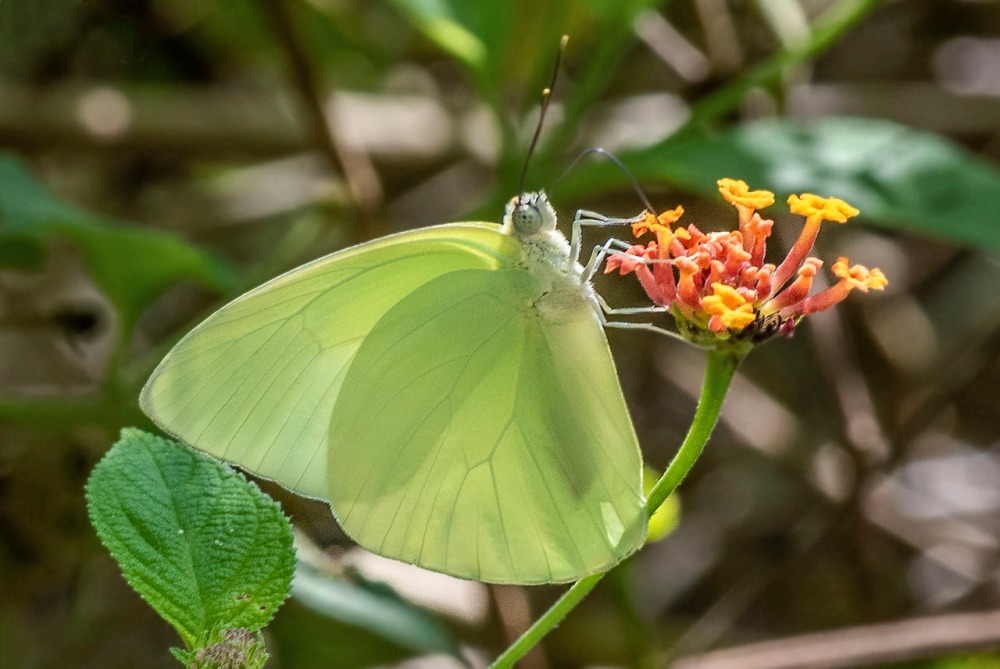
Cloudless Sulphur, (Phoebis sennae)
On the forest trail, I knew there was an Agouti, (Dasyprocta punctata), and White-nosed Coati, (Nasua narica), nearby because of the fresh tracks on the ground. For the same reason, I knew there was a herd of Collared Peccary, (Tayassu tajacu), not too far ahead. As I walked up a muddy incline, listening to the soft trilling call of a Black-throated Trogon, (Trogon rufus), my attention became redirected to a clacking sound that I know very well. Up on top of the ridge were the peccaries, the males snapping their teeth together in a signal of alarm. Peccaries, like the coatis, have exceptionally bad sight and hearing but an excellent sense of smell. If you are downwind of them they quite often have no idea that you are there. If you are upwind of them they will pick up your scent immediately. And so it was with this herd of about ten or twelve, they knew I was there, but also probably had no real fear as they have not been hunted on the grounds for the past ten years. As I continued to walk up the hill they just walked off into the forest to continue about their business.
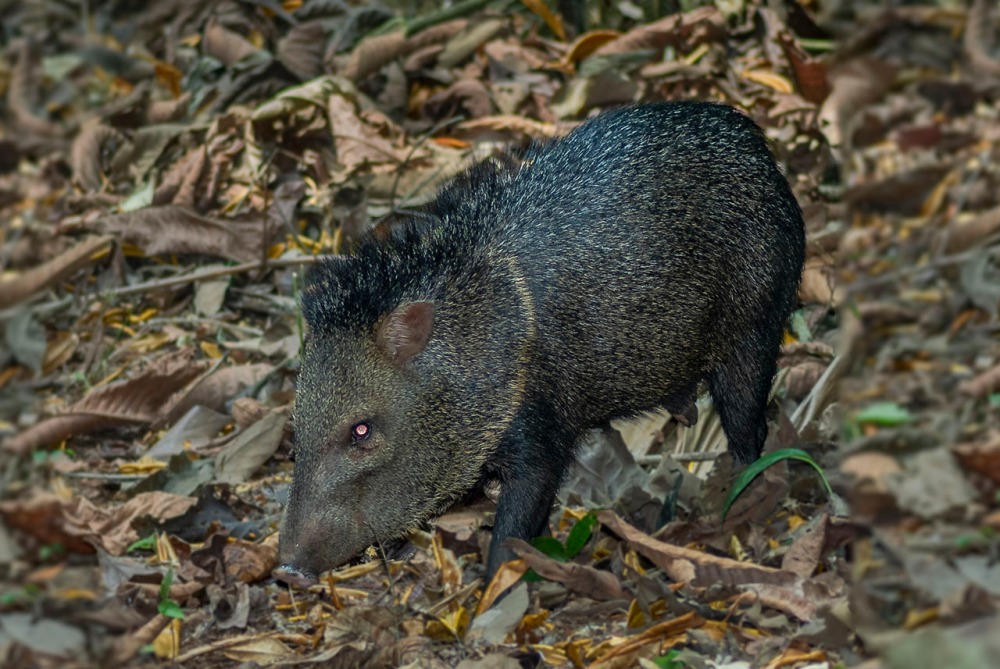
Collared Peccary, (Tayassu tajacu)
There were two other noteworthy sightings today, one a new species of butterfly and the other an occasionally seen species of damselfly. The butterfly was one of the Firetip Skippers, Myscelus assaricus, the forewing divided between orange and black in color with a broad white band. The most eye-catching feature though is the fast “buzzy” flight so typical of some of the skippers. That now makes three new species of butterfly in one week. The damselfly was the Helicopter Damselfly, one of the largest damselflies on the planet. There are several species but this was the impressively large Megaloprepus coerulatus. Helicopter Damselflies are named after their flight pattern, the four transparent wings tipped, in this species, with opaque white and a dark blue/black band, appear to move in the fashion of a helicopters rotors. They are specialized feeders on spiders. They can be seen hovering vertically up and down or horizontally in and out searching spider webs for their occupants. When they find one, they grab it, reverse away from the web nip off the head and legs and then consume the soft body parts.

Helicopter Damselfly, (Megaloprepus caerulatus)
Weird Plants: Balanophoraceae
When people think of a flowering plant, it brings to mind something with roots, a stem, green leaves and when in season, flowers and fruit. Flowering plants evolved 100 million year ago and from that time to this have evolved into thousands of forms, the nearest estimate being in the region of 250,000 species. There are as many as 90,000 species of flowering plants in the Neotropics of which 9,000 species occur in Costa Rica. Flowering plants have flowers; sometimes they are large, showy and colorful, yet other times totally inconspicuous. In shape they make exhibit what we imagine as a typical flower but others may be a bizarre as visual copies of the sex organs of a female bee. Some flowers have a delicious perfume while others may emit the somewhat less attractive odor of rotting flesh. But whatever their size, shape, color or scent, flowers are a plants way of manipulating, amongst other things, insects, birds and bats to do their bidding in terms of bringing about pollination.
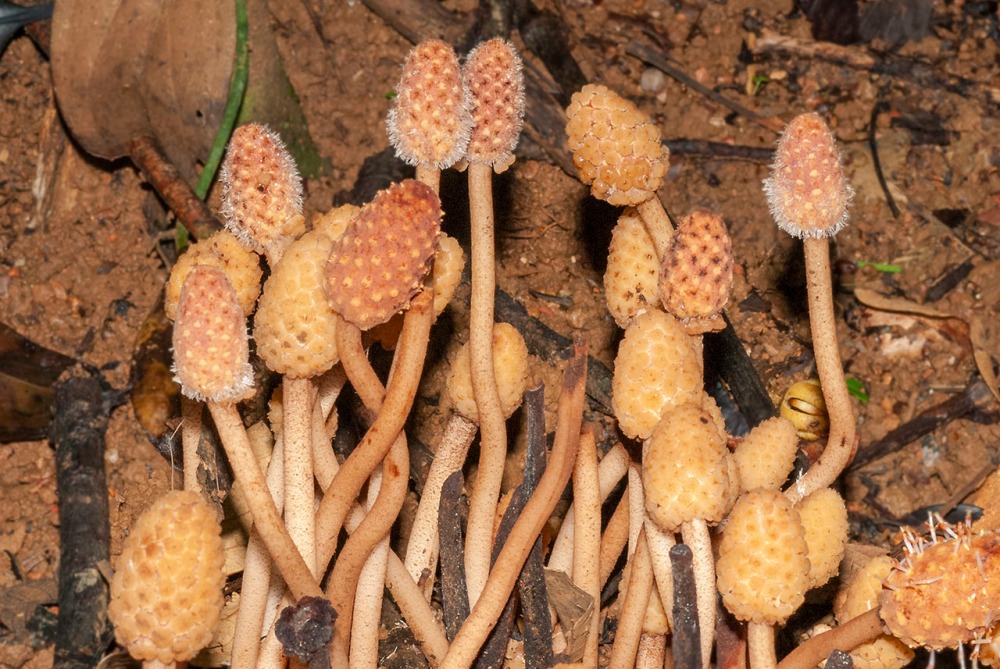
Helosis cayennensis
Now that is a typical flowering plant, but as with everything else, there are going to be some atypical forms. I will quite often have people come and ask me to identify some of the plants and animals they have been photographing during the course of the day. One puzzling sight is a weird little mushroom they may have found growing at the base of a tree. The plant in question is not a fungus, although it takes a lot of convincing of that fact before people will believe it, but rather a strange looking flowering plant, Helosis cayennensis, belonging to the family Balanophoraceae. Arising from subterranean tubers, Helosis cayennensis is a root parasite of other flowering plants. They lack chlorophyll and have a uniform tan color. It is not uncommon to see them but they only occur sporadically at the bases of trees.
Take a look at the photographs and try to decide if having seen this, you would have identified it as a flowering plant.
8.565093
-83.511169
































